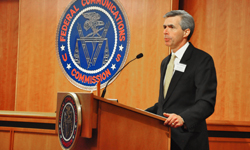No Extensions

In his opening statement, James Barnett, chief of the FCC Public Safety & Homeland Security Bureau made it clear that the Commission does not intend to push back the Jan. 1, 2013, deadline for narrowbanding compliance. (Photo FCC)
On Wednesday, Jan. 26, 150 attendees filled an FCC Commission Meeting Room, and another 350 attendees joined remotely, to learn and discuss how the FCC’s VHF/UHF narrowbanding mandate affects their public safety agencies. Designed to assist licensees in completing the transition to narrowband radio communications, this FCC workshop was led by two panels of subject matter experts.
According to APCO International First Vice President Gregg Riddle, who was in D.C. for the workshop, “The best aspect of the workshop was the diversity of the presenters. They were able to offer a great deal of information on the technical, planning, operational, financial resources, implementation considerations and additional options for those still needing to narrowband.”
Attendees were left with no doubt that the FCC will stick to the Jan. 1, 2013, narrowbanding deadline. Riddle says, “The FCC reaffirmed that they have no intentions of extending the compliance deadline of Jan. 1, 2013. All licensees are expected to comply, and the use of waivers should not be viewed as a simple option [for] narrowbanding.”
Tech Side
The first panel addressed the impact of narrowbanding—its benefits and the consequences of noncompliance—on licensees. Speakers included Barry C. Einsig of the Joint Council on Transit Wireless, Ralph Haller of National Public Safety Telecommunications Council (NPSTC); Jeffrey Johnson of International Association of Fire Chiefs; Farokh Latif of the Spectrum Management Division of APCO International and Paul Patrick of the National Association of State EMS Officials.
During his presentation, APCO AFC Director Farokh Latif provided an update on the status of narrowbanding. Although there is no solid record on the implementation process, research completed by APCO International in December 2010 revealed that “more than 70,000 licensees have not added narrowband emission modifications.”
Latif tells PSC that although narrowbanding does not provide additional channels, it has clear benefits, and “will allow frequency coordinators to pack more users into the same spectrum for with a smaller buffer zone, depending on the technical parameters related to both proposed and incumbent licensees.” This “packing” is only valid in the UHF band and won’t be valid in VHF because of spectrum overlap.
Wisconsin and Illinois were used as examples of states that were successful in migrating to 12 kHz emissions. According to Latif, Illinois developed a four-phase plan in which agencies must coordinate through the State Interoperability Council (SIEC).
Latif also provided some steps for the implementation process:
- Check your call signs.
- Conduct a full radio inventory. (Click here to learn how to conduct an inventory.)
- Determine what equipment can be reprogrammed and what must be replaced. (Click here for a list of narrowband-compliant radios.)
- Secure a budget for all related services and equipment.
- Develop a wideband-to-narrowband system conversion plan that addresses the replacement and installation of radios and base stations, and the actual radio reprogramming.
- Work closely with your two-way radio supplier.
- Schedule and coordinate the system conversion.
- Account for shared frequencies (interoperability channels).
- Remove wideband emission from your license(s).
Other Considerations
During the second panel, representatives from state and local governments discussed budgeting processes and funding for narrowbanding. Speakers included Stephen T. Devine, interoperability program manager for the Missouri Department of Public Safety; and Timothy Lowenstein of Buffalo County, Neb., for the National Association of Counties.
According to Latif, the underlying message was, if your agency is delaying narrowbanding because of funding, don’t. The FCC will take action, and agencies will face “heavy fines” and possibly the revocation of their licenses.
Throughout the proceedings, it became clear that for many attendees the greatest impediments to narrowbanding are funding, technical challenges, interoperability and system topology. Riddle says, “Some licensees have waited until the last minute to address the narrowbanding requirements and are now faced with the additional difficulties caused by the faltering economy.”
Riddle also commented on the failure of licensees to adequately plan for the mandate. He says, “While most people were aware of the requirement, they seemed to be focused on the obstacles to the process instead of developing a plan and then looking at the options to overcome the various roadblocks they have identified.”
Moving Forward
There is no way to know if any of the holders of the 70,000 licenses have made efforts to migrate to narrowband emissions.
It has been implied that the FCC is not going to grant waivers lightly. According to Latif, if you plan to apply for a waiver, you must have a really good reason and need to show some progress toward reaching compliance when you apply, as well as address interoperability with neighboring agencies that have already completed narrowbanding.
If your agency has not yet begun planning for and implementing narrowbanding, start now. Many online resources can help you get the ball rolling.
- The Federal Communications Commission’s official narrowbanding Web site: www.narrowband.us
- FCC Public Safety & Homeland Security Bureau: www.fcc.gov/pshs/public-safety-spectrum/narrowbanding.html
- APCO AFC: www.apcointl.org/frequency
About the Authors
Natasha Yetman is associate editor of APCO International’s magazine, Public Safety Communications. Contact her via e-mail at yetmann@apcointl.org.
Keri Losavio is editor of APCO International’s magazine, Public Safety Communications. Contact her via e-mail at losaviok@apcointl.org or psceditor@apcointl.org.

